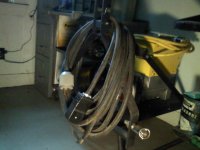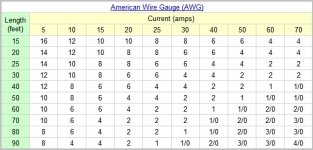I found a heavy extension cord where I used to live that someone had left behind. It had a 50amp receptacle on one end and a 30amp plug on the other for plugging into a dryer outlet. I have used it at times for welding projects away from my shop and close to my house.
Last May, I used the extension cord in welding some 3/8" plate to some 1/2" angle with 5/32" rod to make a weight box for the front of my tractor, and it all went fine.
But the other day, after reading about welding extension cords, I got curious and decided to open the receptacle end up and see what size wire was in there.
I was surprised to see that I had been doing all that welding with 12/3 with ground. Of course the neutral wire wasn't hooked up, but that extra wire in the cable made it fatter and look as though it had bigger gauge wire than it actually had.
But the bottom line is that it worked fine, and when I rolled the extension cord up afterward, I never noticed it being hot.
I guess the reason being that I took my time between rods in chipping slag and wire brushing and kept within the welder duty cycle, and nothing got overheated.
If I had known it was only 12 gauge wire, I probably would have never even tried it. I've used both my Idealarc and Thunderbolt on that cord and hope the machines weren't hurt in any way, but I think they're fine.
Last May, I used the extension cord in welding some 3/8" plate to some 1/2" angle with 5/32" rod to make a weight box for the front of my tractor, and it all went fine.
But the other day, after reading about welding extension cords, I got curious and decided to open the receptacle end up and see what size wire was in there.
I was surprised to see that I had been doing all that welding with 12/3 with ground. Of course the neutral wire wasn't hooked up, but that extra wire in the cable made it fatter and look as though it had bigger gauge wire than it actually had.
But the bottom line is that it worked fine, and when I rolled the extension cord up afterward, I never noticed it being hot.
I guess the reason being that I took my time between rods in chipping slag and wire brushing and kept within the welder duty cycle, and nothing got overheated.
If I had known it was only 12 gauge wire, I probably would have never even tried it. I've used both my Idealarc and Thunderbolt on that cord and hope the machines weren't hurt in any way, but I think they're fine.
Last edited:







